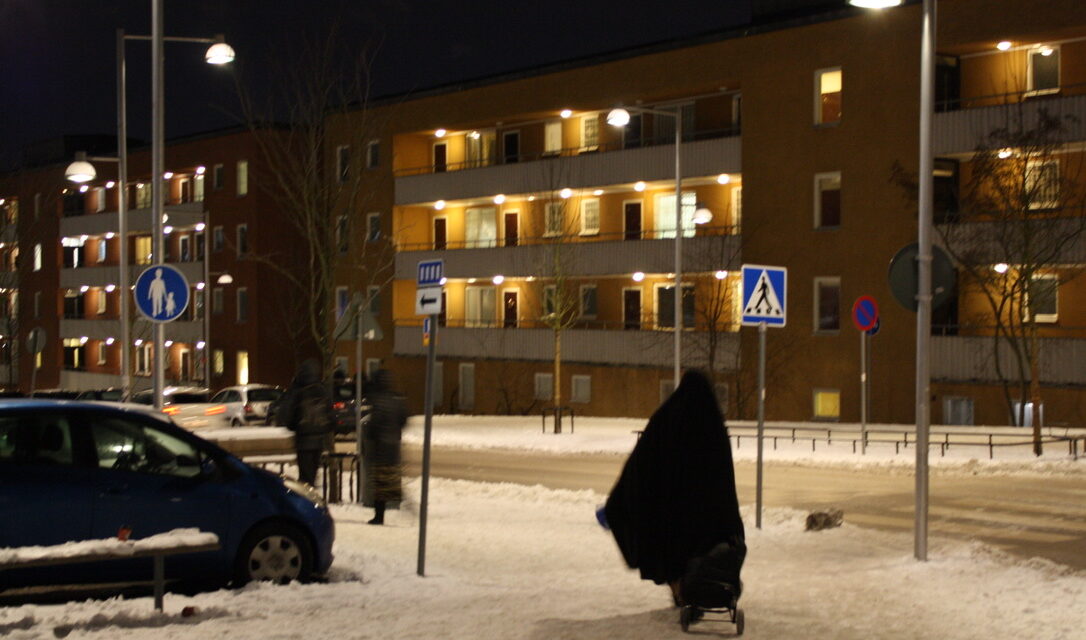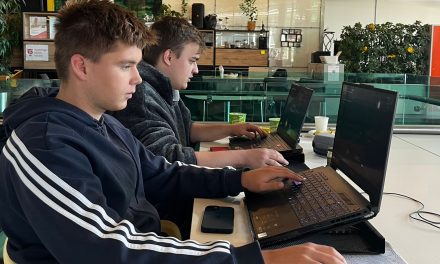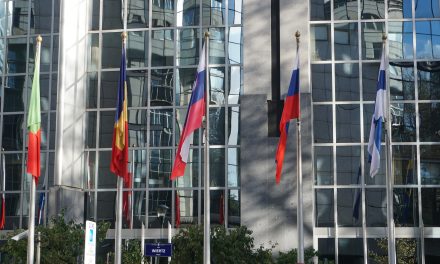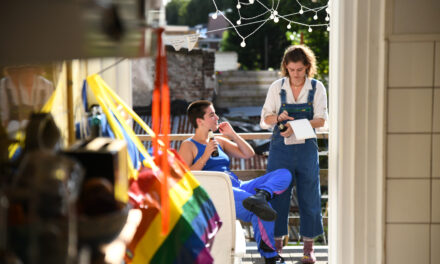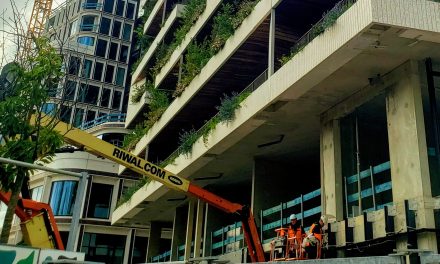Stockholm, the capital of Sweden, is facing new challenges when some districts in the city centre have an average income of five times as much as some suburbs on the outskirts of town. The problem of segregated areas in terms of both class and ethnicity has been pointed out as early as the ’90s but has since only seemed to increase and created major socio-economic challenges for the residents. “These are not immigrant problems or suburban problems, they are societal problems”: said Jonas Lindström, Ph.D. in sociology and author of the book “Segregation”.
Northwest of Stockholm you find the Järva field. Here live over 90 000 citizens, and here social problems that can arise from segregation have become obvious in many ways. In some parts, the greater majority of the population is from a non-Swedish background, unlike the demographics in other districts of the capital. Here, 200-300 children every year do not pass primary school, and the level of education among adults is low due to inaccessibility and language deficiencies. As one of the country’s most exposed areas to crime, the police have since 2015 classified the area as particularly vulnerable.
When the housing construction of the Järva field began in the late ’60s, there were big visions. It was going to be a part of the national housing project called “The Million Program”. One million homes were to be built all over Sweden between 1965 and 1975, to meet the enormous housing shortage that came after the second world war. “A two-room apartment would not cost more than a fifth of what someone working in a factory earned. They were made for both low and middle-income earners, immigrants and workers from the countryside”: said Johan Kihlberg, architectural historian and investigator at the National Board of Housing, Building and Planning.
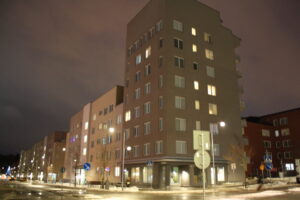
Tall apartment buildings were not ideal for families, since the parents had no contact with their children playing on the streets.
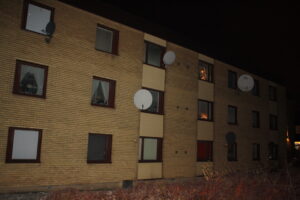
A typical million program facade from the ’70s in Rinkeby, Stockholm.
During the construction of the million program areas, the new construction technique of prefabricated houses was frequently used because of its low costs and efficiency. “It was like building Lego. There were finished walls and floors that you just had to put together. A completely new society could be built in just one or two years.”: said Kihlberg. The entire Järva area was created and inaugurated by its first inhabitants during the years 1969-1971. However, lots of critics were early pointed to the sterile, commercial, and concrete environments. The tall apartment buildings were not ideal for families, since the parents had no contact with their children playing on the streets. Also, people felt no sense of neighborhood yet and had nothing to do in the new societies.
Jonas Lindström has a Ph.D. in sociology, and he has written a book called “Segregation” that explains, among other things, the background, causes, and consequences of segregation. He highlights two big mistakes that were made during the Million Program: “The plan was to mainly build multi-family apartments, however, due to economic development among the people in the early ’70s there was a new demand for single-family houses. Therefore, this kind of housing began to be built instead in other areas, and people with financial capital moved fairly quickly from the million program areas, where the resource-poor people remained left.”
Another mistake Lindström mentions is that when the Million Program was completed in 1975, it was realized that too many homes had been built. Lots of apartments stood empty. “In the ongoing welfare policy in Sweden, there was an idea that every person had the right to an accommodation. So, people who for various reasons ended up outside society or had mental health problems were offered these apartments in the new million program areas. At the same time much unrest was going on in the rest of the world, which resulted in huge refugee immigration in Sweden during the ’70s and ’80s, and they also helped fill the empty apartments. This led to a rapid and tangible social division.”: said Lindström.
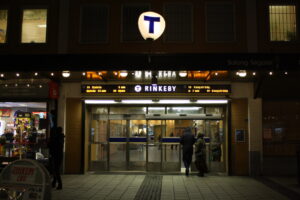
Rinkeby metro station
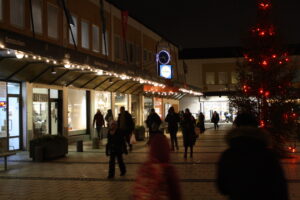
On Rinkeby square there is always a lot of people in motion.
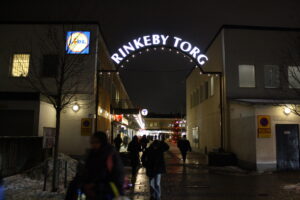
Riinkeby square in Stockholm, Sweden.
In Rinkeby, a suburb in the Järva district, the proportion of residents with a foreign background is over 91 percent. Here lives Mohamed Ali Mohamed, he is 28 years old and has been living in the area for 17 years. “People living here really feel excluded by society. Everyone who does not live here just talks about Rinkeby as an immigrant area, and that the problems that exist here are our own fault”: said Mohamed. He is committed to making the area more attractive so that more people want to move there. For example, he has been involved in the reconstruction of the so-called Rinkebystråket, to transform what was previously Rinkeby’s entrance street with bus and car traffic into a shopping street and meeting place with shops, restaurants and cafés. He thinks that his neighborhood today has most factors that make a society vibrant and attractive. “What needs to be changed are the bad reputations about the suburb as unpleasant, ugly and dangerous”: Mohamed said.
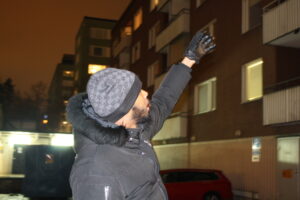
Mohamed Ali Mohamed is committed to making the area more attractive so that more people want to move there.
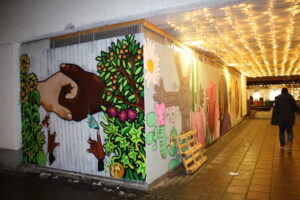
A mural painted on Rinkeby Square.
Lindström points out that in addition to the negative consequences of the Million Program, there are also two parallel normalization processes in society that lead to segregation. “First of all, there is a suburban contempt in Sweden and a norm of the suburb as ugly and unsafe, which makes no one want to move there. Second, today it’s important for people to do a housing career, which didn’t exist in the ’70s when all homes were rental apartments. Since the 90’s it was realized that buying an apartment was an investment as it can go up several million in value over time. And how does a home rise in value apart from being spruced up? Well, it’s quiet, safe, and nice around the home. When an area rises in attraction, then housing prices also rise.” said Lindström.
A bridge for pedestrians, cyclists and public transport has been built a couple of years ago over the motorway that separates Rinkeby and the socio-economically more prosperous area of Ursvik. The idea is to enable contact between different populations, and thus reduce segregation. However, the bridge arouses both anger and hope. Even though the bridge has been completed since 2017, it has not been inaugurated and must not be used. “The criticism of the bridge was great from the residents of Ursvik, as the proximity to Rinkeby makes the newly built apartments difficult to sell. Many of them may be worth less today than when they bought it before the bridge was decided to be built.”: said Jonas Lindström. “They see the bridge as a link to insecurity and crime, we see the bridge as new opportunities for interaction and social meetings. I cross the bridge anyway, I ignore the fences. I’m not going to let them shut me out.”: said Mohamed Ali Mohamed.
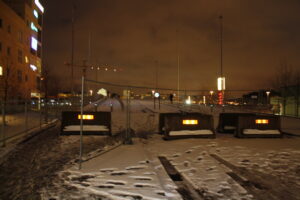
The finished bridge is cordoned off with fencing and must not be used.
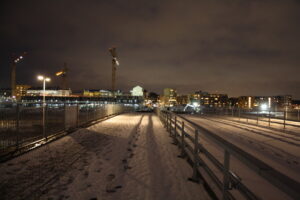
The socio-economically more prosperous area of Ursvik is over the bridge a five-minute walk from Rinkeby.
